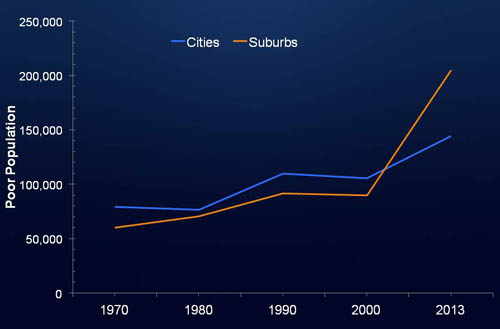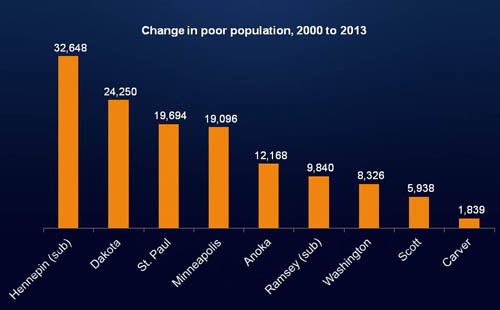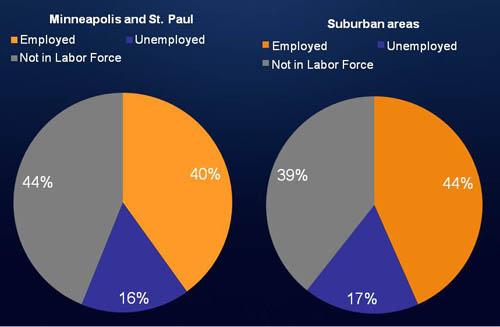 Twin Cities area suburbs and rural areas are home to more people living in poverty than Minneapolis and Saint Paul, and those communities may not be well equipped to deal with the challenge, a Brookings Institution researcher told Metropolitan Council Members in May.
Twin Cities area suburbs and rural areas are home to more people living in poverty than Minneapolis and Saint Paul, and those communities may not be well equipped to deal with the challenge, a Brookings Institution researcher told Metropolitan Council Members in May.
The Brookings’ Alan Berube said that not only is the number of people living in poverty higher in the region’s suburban and rural areas, but that number is growing faster in these areas than in the central cities.
Measures of poverty vary widely, but the Brookings study used the U.S. Census definition. This defines poverty as an annual income of $23,834 or less for a family of four in 2013. The trends would likely be more pronounced if the study’s data included households above the poverty line but not making what is considered a livable wage, Berube said.
Five factors are driving the rapid suburbanization of poverty:
- More rapid suburban growth
- National economic change that has left many longtime suburban households in worse financial shape.
Tackling the challenges of suburban poverty will require innovations in collaboration, integrating strategies across disciplines, and funding strategies.
The Metropolitan Council is already providing leadership in some of these innovations, Berube said, such as Metro HRA, which administers the federal Housing Choice Voucher program in Anoka, Carver, and suburban Hennepin and Ramsey counties.
Suburban and rural poor population has surpassed Minneapolis and Saint Paul
 The poverty rate − the number of people living in poverty as a share of an area’s total population − is higher in the central cities, but the raw number of people living in poverty is greater in the region’s suburbs and rural areas. In those communities, about 168,000 people live in poverty compared with 144,000 in Minneapolis and Saint Paul (U.S. Census, 2013).
The poverty rate − the number of people living in poverty as a share of an area’s total population − is higher in the central cities, but the raw number of people living in poverty is greater in the region’s suburbs and rural areas. In those communities, about 168,000 people live in poverty compared with 144,000 in Minneapolis and Saint Paul (U.S. Census, 2013).
Berube said the Twin Cities area mirrors the national trend, where suburbs are home to the largest and fastest-growing population of people living in poverty. Many longtime residents of these areas have seen their financial circumstances worsen, especially with the economic recession, he said. But they may also have been struggling for some time just to get by.
Factors driving the suburbanization of poverty
Here’s a little deeper look at the five primary factors have been driving the rapid suburbanization of poverty, according to Berube.
- Population change – Suburbs continue to grow faster than central cities, and as they do, their population begins to resemble more and more the population of America as a whole. In the seven-county metro, between 2000 and 2013, the population of Minneapolis and Saint Paul grew 4% while the suburban population grew 17%.
- Immigration – In contrast to earlier decades, immigrants are more and more locating directly in suburbs rather than starting in central city portal neighborhoods and then moving outward, as they did in the past. And these households, at least initially, tend to have lower incomes.
- Housing opportunities – As of 2008, a majority of the housing units that rent at what are called fair market rates or below are in the suburbs in the Twin Cities region, as are the majority of Section 8 Housing Choice Voucher holders.
- Jobs – Between 2000 and 2010, the number of jobs within 10 miles of downtown Minneapolis and Saint Paul shrank 2%, while the number of jobs outside that area grew 10%. Much of this growth has been in lower-paying jobs, such as retail and hospitality.
- Economic change – Longtime residents of suburban communities have worsened economic circumstances due to national economic trends in the last 12 years.
This last point is important to emphasize to suburban leaders,who may be reticent about addressing the needs of low-income populations, Berube said. For example, leaders may fear that by building housing choices appropriate for these populations “‘…we’ll just attract 'these 'people’ when in fact these people are already living in your community and struggling to get by and have been doing so for some time.”
Many working people live in poverty
 In this region, more than half of working-age people who live below the poverty line in both the central cities and in the suburban areas are either working or they are actively looking for work, according to the Brookings’ study.
In this region, more than half of working-age people who live below the poverty line in both the central cities and in the suburban areas are either working or they are actively looking for work, according to the Brookings’ study.
“Unfortunately, the connection between poverty and work is strengthening in the American economy, and more and more suburbs are reflecting that reality,” Berube said.
Suburban poverty poses special challenges
Some suburban areas have limited access to transit, but he noted that the Twin Cities region has done better than most around the country to provide transit service to suburban jobs. He said about 65% to 70% of suburban low-income households have a car and many commute to jobs in other suburbs, but those who struggle most financially rely on transit.
Another challenge is that there tends to be a “thinner” safety net in these areas and more limited social services funded by nonprofit foundations. Federal anti-poverty programs can be difficult for suburban and rural communities to use because they’re geared to operate in more urban settings. Also, schools may not have the dollars needed to meet the needs of changing student populations.
But several approaches can help, including:
- Achieving scale – Work effectively across community contexts to meets local needs (such as Metro HRA).
- Collaborate and integrate – Collaborate across places and integrate strategies across disciplines, such as workforce development and affordable housing. Berube cited Thrive MSP 2040, the foundational chapter of the Council’s Regional Development Guide, for the way it embraces integrated goals for housing, transportation, water, and parks.
- Fund strategically – Leverage resources to unlock public and private capital. Berube said that this region’s Fiscal Disparities program is one kind of strategy to level the playing field and is seen as a national model.
More information
Watch Berube's presentation and the discussion that followed.